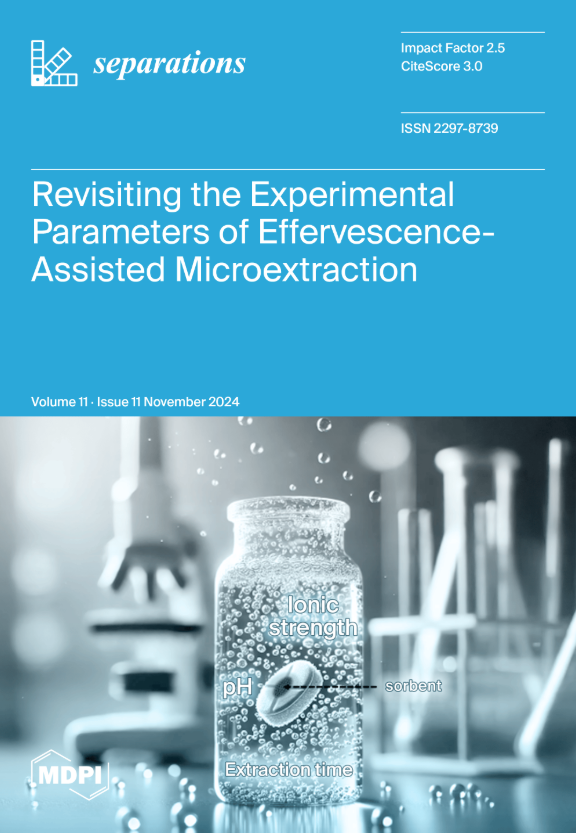Adsorption Performance and Mechanism of H3PO4-Modified Banana Peel Hydrothermal Carbon on Pb(II)
IF 2.7
4区 工程技术
Q3 CHEMISTRY, ANALYTICAL
引用次数: 0
Abstract
This study investigated the adsorption performance of hydrothermal carbon derived from banana peel and modified with different concentrations of phosphoric acid solution, then used to adsorb lead ions in an aqueous solution. The surface structure and functional groups of the modified hydrothermal carbon were analyzed using XRD, SEM, FT-IR, elemental analysis, and BET. The results showed that the adsorption capacity of modified hydrothermal carbon derived from banana peel reached 40.64 mg/g at a hydrothermal temperature of 240 °C, a phosphoric acid solution of 2 mol/L, and a solid–liquid ratio of 2 g/L, with a removal efficiency of 82.74%. The adsorption process conformed to the pseudo-second-order kinetic model and the Langmuir isotherm equation. The correlation coefficient of 0.99 for fitting the adsorption process using an artificial neural network, indicating that the artificial neural network could be used to predict adsorption. The adsorption of Pb(II) from an aqueous solution by phosphoric acid-modified hydrothermal carbon was dominated by monolayer chemical adsorption, and the adsorption mechanisms included electrostatic attraction, ion exchange, surface complexation, and physical adsorption.H3PO4 改性香蕉皮热液碳对铅(II)的吸附性能和机理
本研究考察了从香蕉皮中提取并用不同浓度的磷酸溶液改性后的水热炭对水溶液中铅离子的吸附性能。利用 XRD、SEM、FT-IR、元素分析和 BET 分析了改性水热炭的表面结构和官能团。结果表明,在水热温度为 240 ℃、磷酸溶液为 2 mol/L、固液比为 2 g/L 的条件下,香蕉皮改性水热炭的吸附容量达到 40.64 mg/g,去除率为 82.74%。吸附过程符合伪二阶动力学模型和 Langmuir 等温线方程。利用人工神经网络拟合吸附过程的相关系数为 0.99,表明人工神经网络可用于预测吸附。磷酸改性热液炭对水溶液中铅(II)的吸附以单层化学吸附为主,吸附机理包括静电吸引、离子交换、表面络合和物理吸附。
本文章由计算机程序翻译,如有差异,请以英文原文为准。
求助全文
约1分钟内获得全文
求助全文
来源期刊

Separations
Chemistry-Analytical Chemistry
CiteScore
3.00
自引率
15.40%
发文量
342
审稿时长
12 weeks
期刊介绍:
Separations (formerly Chromatography, ISSN 2227-9075, CODEN: CHROBV) provides an advanced forum for separation and purification science and technology in all areas of chemical, biological and physical science. It publishes reviews, regular research papers and communications. Our aim is to encourage scientists to publish their experimental and theoretical results in as much detail as possible. There is no restriction on the length of the papers. The full experimental details must be provided so that the results can be reproduced. There are, in addition, unique features of this journal:
Manuscripts regarding research proposals and research ideas will be particularly welcomed.
Electronic files and software regarding the full details of the calculation and experimental procedure, if unable to be published in a normal way, can be deposited as supplementary material.
Manuscripts concerning summaries and surveys on research cooperation and projects (that are funded by national governments) to give information for a broad field of users.
The scope of the journal includes but is not limited to:
Theory and methodology (theory of separation methods, sample preparation, instrumental and column developments, new separation methodologies, etc.)
Equipment and techniques, novel hyphenated analytical solutions (significantly extended by their combination with spectroscopic methods and in particular, mass spectrometry)
Novel analysis approaches and applications to solve analytical challenges which utilize chromatographic separations as a key step in the overall solution
Computational modelling of separations for the purpose of fundamental understanding and/or chromatographic optimization
 求助内容:
求助内容: 应助结果提醒方式:
应助结果提醒方式:


